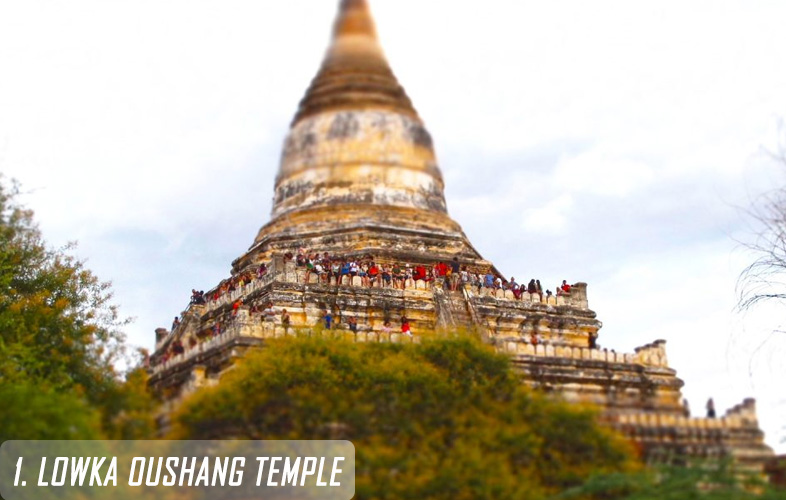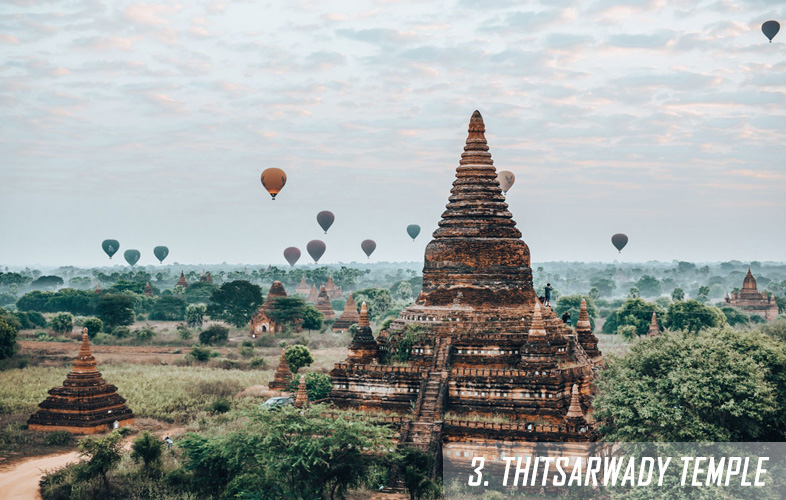
- On 8 September, 2020
- In ALL BLOGS MYANMAR BLOGS
- Tags Tags: ANANDA TEMPLE, DHAMMAYANGYI TEMPLE, GAWDAWPALIN TEMPLE, HTILOMINLO TEMPLE, HTUKKANTHEIN TEMPLE, LAWKAOUSHAUNG TEMPLE, SULAMANI TEMPLE, TA WET (THE SECRET TEMPLE), THAMBULA TEMPLE, THITSARWADY TEMPLE
MYANMAR’S 10 MUST-SEE TEMPLES
This blog features a list of stunning Myanmar temples, which you must visit during your trip to the country. As you read, you will also get to know important details regarding each of it while exploring the Myanmar temples history. So, let’s begin!
LAWKAOUSHAUNG TEMPLE

Shwesandaw Pagoda is the most popular sunrise spot, however it’s always packed with a huge crowd. If you want to experience an incredible sunrise without another tourist in sight, find the Lawkaoushaung Temple.
THITSARWADY TEMPLE

Dating to 1334, the Thitsarwadi Temple also called Thitsa wadi or Thissa wadi is one of the middle-sized temples in Bagan (Burma). It lies in the southeastern part of the archaeological zone. Although Thitsarwadi temple is not one of the grandest temples, it is still worth a visit, as it is one of the few that has terraces to climb, and offers great views of the Bagan plain.
It has been extensively renovated, mostly from the outside with decorations. Inside the temple are beautiful stucco work and interesting murals. On each side of a square pillar, in the middle of the building, is another statue of the Buddha.
TA WET (THE SECRET TEMPLE)

A little secret place is the Ta Wet Hpaya Pagoda. We discovered it thanks to a young souvenir salesman who took us there. Although we were not the only visitors during our visit (there were about 30 other people on site with us), the pagoda sees much less traffic from visitors in comparison to the other well-known pagodas.
It was amazing from up here, to take in the incredible panoramic view of Bagan from this temple. You’ll find that it’s quite a distance from all the other pagodas. But you come to realise that no two pagodas are the same and that each has its pros and cons
ANANDA TEMPLE

If you follow the main road in the direction of Alt-Bagan, you will reach the Ananda Temple just before the gates of the city. The Ananda Temple (or also called Ananda Phaya) is, for us, one of the absolute must-see temples in Bagan.
Even from the outside, the white temple with the golden stupa stands out from amongst its crowd. No other temple in Bagan resembles the Ananda Temple and that makes it especially intriguing and unique. The temple has also been beautifully renovated, with four giant standing Buddhas inside, facing the four cardinal points, like many of the Buddhist temples in Myanmar.
GAWDAWPALIN TEMPLE

Gawdawpalin Temple is the second tallest temple in Bagan. Similar in layout to the Thatbyinnyu Temple, the temple is two storeys tall, and contains three lower terraces and four upper terraces. The temple was heavily damaged during the 1975 earthquake and was reconstructed in following years.
The Gawdawpalin Temple belongs to the style of the hollow gu-style temple. In contrast to the stupas, the hollow gu-style temple is a structure used for meditation, devotional worship of the Buddha and other Buddhist rituals. The gu temples come in two basic styles: “one-face” design and “four-face” design—essentially one main entrance and four main entrances. Other styles such as five-face and hybrids also exist. The one-face style grew out of 2nd century Beikthano, and the four-face out of 7th century Sri Ksetra. The temples, whose main features were the pointed arches and the vaulted chamber, became larger and grander in the Bagan period.
DHAMMAYANGYI TEMPLE

Dhammayangyi Temple is a Buddhist temple located in Bagan, Myanmar. Largest of all the temples in Bagan, the Dhammayan as it is popularly known was built during the reign of King Narathu(1167-1170). Narathu, who came to the throne by assassinating his father Alaungsithu and his elder brother, presumably built this largest temple to atone for his sins.
The Dhammayangyi is the widest temple in Bagan, and is built in a plan similar to that of Ananda Temple.[3] Burmese chronicles state that while the construction of the temple was in the process, the king was assassinated by some Indians and thus the temple was not completed. Sinhalese sources however indicate that the king was killed by Sinhalese invaders.
The temple’s interior is bricked up for unknown reasons, thus only the four porches and the outer corridors are accessible
SULAMANI TEMPLE

The Sulamani Temple is a Buddhist temple located in the village of Minnanthu (southwest of Bagan) in Burma. The temple is one of the most-frequently visited in Bagan.
It was built in 1183 by King Narapatisithu,:178 and is similar to the Thatbyinnyu Temple in design. The Sulamani Temple also shows influence from the Dhammayangyi Temple, and was the model for the Htilominlo Temple. Sulamani Temple was restored after the 1975 earthquake, and utilises brick and stone, with frescoes in the interior of the temple. It was rebuilt in 1994.
THAMBULA TEMPLE

Thambula is the name most commonly used for this temple but its true name in Bamar is Thonlu La, derived from the original Pali name Tiloka Canda Devi, Moon of the Three Worlds. The name Thonlu La is written on the stone inscription found within the temple.
Being one of the interesting destinations to visit on Bagan, it captures tourist’s attention a beautiful structure, square in plan, and set on a plinth. The stucco details are delicate and elegant. The interior walls are painted with murals, and one shows a winged Keinara bird-man with human feet instead of birds’ claws, as is more usual.
HTILOMINLO TEMPLE

From Shwezigon Pagoda, follow the main road towards Old Bagan. It’s not too long of a drive before you reach the Htilominlo Temple. However, this is not one of those temples that we’d go out of our way to get to, as it didn’t really astounded us. But since it was located along the main road, we thought “why not?” And actually found the stopover quite worthwhile. We particularly liked the view from a nearby flat roof pagoda on the Htilominlo temple.
A young saleswoman from a nearby souvenir shop actually told us about this and brought us to the viewpoint herself. We were a little skeptical at first but glad we trusted her good intentions. (We wanted to buy one or two souvenirs anyway, so that was all good.) You can find this flat roof pagoda as you leave the Htilominlo temple via the west exit.
HTUKKANTHEIN TEMPLE

Htukkanthein is one of the most famous temples in the ancient Arakanese city of Mrauk U, in Rakhine State, Western Myanmar. The name means “Cross-Beam Ordination Hall”.
Like most of Mrauk U’s Buddhist temples, it is designed as a dual purpose ‘fortress-temple’. Although it is a ‘thein’ (ordination hall), it is one of the most militaristic buildings in Mrauk U, built on raised ground, with a single entrance and small windows. According to Dr. Emil Forchhammer, an archaeologist employed by the British Raj to study Mrauk U in the late 19th century, the temples might have been employed as a refuge for the Buddhist religious order in times of war
The temple enshrining the statues of Buddha was built in 1571 by King Min Phalaung. It is located on a small hill a stone’s throw away from the Shite-thaung Temple. At the centre of the temple is a dome topped with a mushroom shaped crown or hti, surrounded by four smaller stupas at the corners. At the facade base of the central dome is a square window designed in such a manner that, at dawn, the sun’s rays shine directly onto the main Buddha image inside the central vault. At the west side of the temple is a small meditation chamber, accessible only via the main temple.